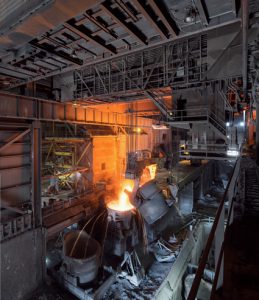
ArcelorMittal’s research in developing processes to use less energy in steel production secured a major boost.
The company’s global research and development center in East Chicago received two High-Performance Computing for Manufacturing Program (HPC4Mfg) grants through a Department of Energy initiative. The DOE announced $3.3 million in federal funding for 11 manufacturing and materials projects aimed at solving technical challenges in manufacturing and materials development in the U.S.
“These awards from the DOE engage national labs and industry to benefit industry and ultimately conserve energy,” said Mark Atkinson, senior director, global research and development. “High-performance computing (HPC) capitalizes on the computational horsepower that exists in the national labs that we do not have at ArcelorMittal. Together, we can solve complicated problems and accelerate product development to meet our stringent quality and sustainability goals.”
The first grant ArcelorMittal will partner with Lawrence Livermore National Laboratory (LLNL), and Argonne National Laboratory (ANL) to establish a method for rapid product development of next generation high-strength steels. ArcelorMittal’s typical product development lifecycle is between four and six years, which consists of developing new chemistries and testing the chemistries repeatedly until proven successful.
The labs, along with ArcelorMittal, will use HPC at the atomistic scale and artificial intelligence (AI) with the aim of reducing the development time, the company said.
“This can be a tedious cycle and we are always looking for new ways to cut down on the product development time to bring new automotive steel grades faster to our customers,” said Brian Lin, research engineer, product development with ArcelorMittal.
Energy savings would be realized by eliminating portions of the plant’s trial phases. Testing coils is extremely energy and cost intensive if the trial coils do not meet the property requirements, the company said.
With the second grant, the company will collaborate with Ridge National Laboratory (ORNL) and Purdue University Northwest to reduce the yield loss caused by impurities forming in the refining ladle process. In the steelmaking process, impurities must be eliminated to achieve optimal product performance.
The company said the only way to remove impurities is when the steel is molten. This study, taking place at the ladle at Indiana Harbor’s #3 steel producing operation, will examine techniques to produce cleaner steels.
The goal is to conserve energy for ArcelorMittal USA by increasing the probability of melting steel correctly the first time, the company said.
“We have a long history working with Purdue University Northwest and they have vast expertise in the ladle process as well as simulating that process,” said Pallava Kaushik, manager, steelmaking and casting with ArcelorMittal.
“This is perfect collaboration with ArcelorMittal representing the operations, Purdue Northwest representing academia and ORNL providing computer devices. We are expecting usable results which can be effectively implemented during the ladle refining process in multiple plants in our company.”




